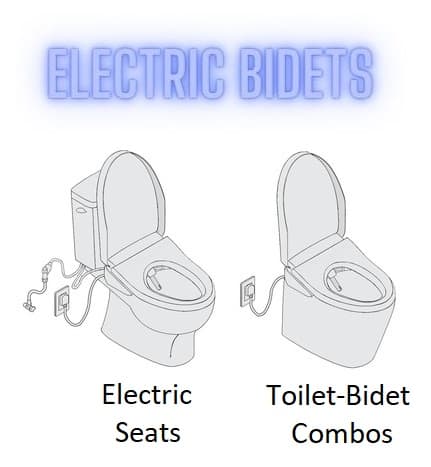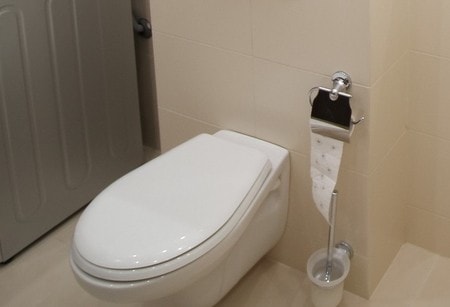Have you ever wondered about the wonders of a bidet, but hesitated because you weren’t sure about compatibility?
We’ve all been there, contemplating whether our bathroom setup can accommodate this game-changing innovation.
But the burning question remains: Can you install a bidet on any toilet?
We understand the confusion and concerns that come with navigating the world of bidets and toilet designs.
That’s why we’ve created the ultimate guide to bidet compatibility, designed to put your mind at ease and help you make the best decision for your home.
In this comprehensive guide, you’ll uncover the secrets to seamlessly integrating a bidet into your existing bathroom, regardless of your toilet type.
So, say goodbye to uncertainty and hello to a fresh, clean, and more sustainable bathroom experience. Together, we’ll explore the perfect bidet solution for you and your home, leaving you feeling confident and excited about your bathroom upgrade.
Types of Bidets
Bidets have gained popularity in recent years for their hygienic benefits and environmentally friendly aspects.
There are several types of bidets available, each with its unique features and functionality.

This section provides an overview of the various kinds of bidets you can choose from to find the perfect match for your bathroom.
Stand-alone Bidets
These traditional bidets are separate fixtures installed next to the toilet. Stand-alone bidets often resemble a low sink and require additional space in the bathroom. They offer a hands-free cleaning experience but may necessitate professional installation.
Bidet Toilet Seats
Bidet toilet seats replace your existing toilet seat and include built-in bidet functions. These seats typically come with adjustable water pressure, temperature control, and even air-drying capabilities. They are easy to install and do not require additional bathroom space.
Handheld Bidets
Also known as bidet showers or bidet sprayers, handheld bidets are nozzles attached to a flexible hose connected to the water supply. They offer a manual, targeted cleaning experience and can be installed easily without the need for professional help.
Attachment Bidets
Attachment bidets are a budget-friendly option that can be installed directly under your existing toilet seat. These attachments connect to the water supply and provide basic bidet functions like adjustable water pressure. However, they may lack advanced features like temperature control and air drying.
Bottle Top Bidets
A portable and travel-friendly option, bottle top bidets are designed to fit on top of a water bottle. These bidets are ideal for those who require a bidet while on the go, but may not provide the same level of comfort and convenience as other types.
Smart Bidets
Smart bidets offer the most advanced features and technology in bidet options. They typically include customizable settings, remote control, and even smartphone integration. These bidets are a luxurious option for those seeking the ultimate bathroom technology and comfort.
When choosing a bidet, consider the available space in your bathroom, your budget, and the specific features you desire for the best overall experience.
Toilet Designs and Their Compatibility With Bidets
When choosing a bidet, it’s essential to consider the design of your existing toilet and ensure the bidet is compatible.
Toilet designs can vary significantly, and some may require specific types of bidets or attachments. This section will guide you through the various toilet designs and their compatibility with bidets.
Standard Toilets
Most bidet attachments and seats are designed to fit standard toilets, including elongated and round shapes.
If your toilet has a distance of 5 to 8 ¼ inches between the mounting bolt holes and at least ¾ inches of clearance from the toilet tank, you should have no issues installing a bidet attachment or seat.
Deep French Curve Toilets
Deep French curve toilets have a unique design with limited space near the mounting bolts. These one-piece toilets may not be compatible with some bidet seats and attachments, such as Bio Bidet models.
If you have a deep French curve toilet, it’s essential to contact the bidet manufacturer with your toilet’s make and model for a compatibility check.
American Standard Toilets
American Standard toilets come in various designs, and some may require specific bidets or attachments.
For cold-water bidet attachments, the Bio Bidet SlimEdge Bidet Attachment is a suitable option.
For a warm water attachment, consider the Bio Bidet 270 Duo. If you’re looking for a bidet seat, the AC 1.0 Spalet Elongated Bidet Seat is an excellent choice for American Standard toilets.
Bidet Toilet Combinations
Also known as smart toilets, bidet toilet combinations integrate the best bidet seat features with a toilet.
These all-in-one designs represent the pinnacle of modern bidet design, and compatibility issues are not a concern, as the bidet and toilet are a single unit.
When selecting a bidet for your bathroom, it’s crucial to consider your toilet design and ensure compatibility.
Make sure to measure your toilet dimensions and consult the bidet manufacturer for guidance if you’re unsure about the best option for your specific toilet design.
Factors to Consider Before Installation of a Bidet
Installing a bidet in your bathroom can provide a luxurious and refreshing experience. However, before making the leap, it’s essential to consider the various factors involved in the installation process.
This section will outline some key aspects to help ensure a smooth and successful bidet installation.
Electrical Logistics
One of the most challenging components of installing a bidet is figuring out the electrical logistics, especially for electric bidets.
Ensure that you have access to a nearby power outlet and that it meets the power requirements for your chosen bidet model.
Plumbing Requirements
To install a separate bidet, you will need specific plumbing components, including:
- Two 3/8″ shutoff valves (hot and cold)
- 1-1/4″ drain stub-out (in the wall or floor)
- 1-1/4″ P-Trap
- Backflow preventer (air gap or vacuum breaker)
Make sure to consult with a plumber if you are unsure about the plumbing requirements for your bidet.
Fixture Installation
Most bidets come with fixtures included. When installing these fixtures, be careful not to scratch the finishes.
Proper fixture installation ensures that your bidet functions correctly and maintains its aesthetic appeal.
Handheld Bidets and Smart Toilets
Handheld bidets are relatively easy to install and use, making them a popular choice for those looking for a simple solution.
Smart toilets, on the other hand, combine high functionality and modern technology.
These toilets often come with built-in bidets and no-touch operation, allowing for a more seamless and luxurious experience.
DIY or Professional Installation
Some bidet models, like non-electric bidet attachments, can be easily installed by the user. However, more complex models or separate bidets may require professional installation.
Evaluate your comfort level with DIY projects and consider hiring a professional if necessary.
By considering these factors, you can ensure that your bidet installation process goes smoothly and results in a comfortable and functional addition to your bathroom.
Installation Process for Different Bidet Types
The process of installing a bidet varies depending on the type you choose.
This section will outline the general installation steps for standalone, built-in, and handheld models, as well as bidet attachments.
Standalone Bidets
- Preparation: Turn off the water supply and assemble the bidet according to the manufacturer’s instructions.
- Placement: Temporarily position the bidet over the drain and ensure that the flexible water supplies line up properly.
- Marking: Using a marker or pencil, mark the placement of the bidet and bolt holes on the floor.
- Drilling: Predrill the holes for the bolts using a template (if supplied) or the markings made earlier.
- Mounting: Align the bidet with the drilled holes and connect all the bolts to secure it in place.
Built-in Bidets
- Supply Lines: For floor-mounted bidets, lay the supply lines first.
- Mounting: Follow the manufacturer’s instructions to mount the bidet to the floor or wall, depending on the model.
Handheld Bidets
- Assembly: Assemble the sprayer and hose according to the manufacturer’s instructions.
- Connection: Attach the sprayer and hose to the appropriate water supply lines.
Bidet Attachments
- Toilet Preparation: Remove the toilet seat and follow the manufacturer’s instructions to prepare the toilet for the attachment.
- Attachment Installation: Install the bidet attachment according to the provided instructions, ensuring proper alignment with the drainage and water supply lines.
- Toilet Seat Reinstallation: Reinstall the toilet seat, making sure it fits securely over the bidet attachment.
Regardless of the bidet type, it is crucial to read the manufacturer’s installation instructions carefully to ensure a successful installation.
Each model may have specific steps or requirements that need to be followed.
By understanding the process for your chosen bidet type, you can create a comfortable and functional addition to your bathroom.
Potential Challenges and Solutions for Bidet Installation
Installing a bidet can come with a few challenges, but with the right tools and knowledge, you can overcome them.
This section will highlight some of the common issues and provide solutions to ensure a successful bidet installation.
Electrical Logistics
One of the most challenging aspects of installing a bidet can be figuring out the electrical logistics. To tackle this issue, consider the following:
- Location: Choose a location near an electrical outlet, or have a licensed electrician install one if necessary.
- Voltage: Ensure the electrical supply matches the requirements of the bidet, as specified by the manufacturer.
Plumbing Components
Proper installation of plumbing components is crucial for a successful bidet installation. Make sure you have the following items:
- Two 3/8″ shutoff valves (hot and cold)
- 1-1/4″ drain stub-out (in the wall or floor)
- 1-1/4″ P-Trap
- Backflow preventer (air gap or vacuum breaker)
Bidet Fixtures
Be cautious when installing the fixtures on the bidet, as scratching the finishes can compromise the aesthetic appeal.
Follow the manufacturer’s instructions for proper installation and handle the fixtures with care.
Bidet Overflow and Drain
To prevent water damage, it’s essential to properly install the bidet overflow and drain. Attach the overflow drain according to the manufacturer’s guidelines.
Sealant Application
When installing a bidet, using sealant around the base is necessary to create a watertight seal. Apply silicone sealant and wipe away any excess with a moistened finger.
Tool Selection
Choose the correct wrench or adjustable open-faced socket for the bidet you are installing. Using the appropriate tools will help ensure a secure connection between the bidet and the toilet.
By addressing these potential challenges, you can ensure a smooth and successful bidet installation. Always follow the manufacturer’s instructions and consult a professional if you encounter any issues beyond your expertise.
Professional Help and DIY Options for Bidet Installation
When it comes to installing a bidet, you can choose between professional help or a DIY approach. In this section, we will explore both options, highlighting their advantages and considerations.
Professional Help
Hiring a professional plumber or contractor for bidet installation ensures a seamless process with minimal risk. Advantages of professional help include:
- Expertise: Professionals possess the necessary skills and knowledge to install a bidet correctly.
- Time-saving: Hiring a professional can save you time, as they can complete the installation efficiently.
- Warranty: Some manufacturers require professional installation to maintain the warranty on their products.
However, professional help can be more expensive than a DIY approach, with the average total cost of bidet installation ranging from $100 to $1,000, depending on the bidet type.
DIY Options
If you’re comfortable with basic plumbing and following instructions, you may opt for a DIY bidet installation. Advantages of DIY installation include:
- Cost-saving: DIY installation can save you money, as you won’t need to pay for professional labor.
- Customization: You have control over the installation process and can tailor the setup to your preferences.
To successfully install a bidet yourself, follow these general steps:
- Predrill holes: Locate and predrill holes for bolts using a template or by aligning the bidet’s drain hole with the trap and waste pipe in the floor.
- Install fixtures: Carefully install the fixtures on the bidet, avoiding scratches on the finishes.
- Connect water supply: Attach hot and cold water supply lines.
- Connect drain line: Connect the drain line to the bidet.
- Check for leaks and seal: Ensure all connections are secure and apply sealant where necessary.
Keep in mind that DIY installation may void the warranty on some bidets, so it’s essential to review the manufacturer’s guidelines before proceeding.
When deciding between professional help and a DIY approach, consider your skill level, budget, and the specific requirements of your chosen bidet.
By weighing the pros and cons, you can make an informed decision and enjoy the benefits of your new bidet.
FAQs
Can you install a bidet on a regular toilet?
Yes, you can install a bidet on a regular toilet. Bidet attachments and bidet toilet seats are designed to fit most standard toilets.
Do bidets work on all toilets?
Most bidets are compatible with a wide range of toilets, but it’s essential to check the manufacturer’s guidelines for specific compatibility requirements.
Do I need a new toilet for a bidet?
No, you don’t need a new toilet for a bidet. You can either install a bidet attachment, bidet toilet seat, or a standalone bidet alongside your existing toilet.
How do you install a bidet on a one-piece toilet?
Installing a bidet on a one-piece toilet typically involves removing the existing toilet seat, attaching the bidet seat or attachment, connecting the water supply, and following the manufacturer’s instructions.
Why don’t all toilets have bidets?
Not all toilets have bidets due to cultural preferences, cost considerations, and lack of awareness about the benefits of bidets.
Do you need extra plumbing for a bidet?
Bidet attachments and bidet toilet seats usually don’t require extra plumbing, as they connect to the existing water supply. Standalone bidets may require additional plumbing for proper installation.
How hygienic are bidets?
Bidets are considered hygienic as they provide a more thorough and gentle cleaning compared to toilet paper, reducing the risk of irritation and infection.
Do bidets fully clean?
Bidets provide a more thorough clean than toilet paper alone, but it’s still essential to practice good personal hygiene for optimal cleanliness.
Do bidets get you wet?
Yes, bidets use a stream of water to clean, which may leave you slightly wet. You can gently pat dry with toilet paper or a designated towel after using a bidet.
Why are bidet toilets so expensive?
Bidet toilets can be expensive due to the advanced technology, materials, and features they offer. However, there are more affordable options like bidet attachments and bidet toilet seats available.
Do bidet toilets need electricity?
Some bidet toilets require electricity for features like heated seats, warm water, and air drying. Non-electric bidet attachments and seats are also available.
Why not to get a bidet?
Reasons to avoid getting a bidet might include personal preference, limited bathroom space, or budget constraints.
Why can’t I install a bidet on my toilet?
Incompatibility between your toilet and the specific bidet model or plumbing constraints might prevent you from installing a bidet on your toilet. Always check the manufacturer’s guidelines for compatibility.
Does one wipe after using the bidet?
After using a bidet, you can gently pat dry with toilet paper or a designated towel to remove any remaining moisture.
What plumbing is needed for a bidet?
Bidet attachments and bidet toilet seats typically require a connection to the existing water supply. Standalone bidets may need additional plumbing, including hot and cold water supply lines and a drain connection.
Conclusion
In conclusion, bidet compatibility is more accessible than ever, with a wide range of options to suit various toilet styles and bathroom setups.
Whether you choose a bidet attachment, bidet toilet seat, or standalone bidet, you can elevate your bathroom experience and embrace the hygienic benefits of bidet use.
Don’t let compatibility concerns hold you back – explore the world of bidets and discover the perfect fit for your bathroom today!


